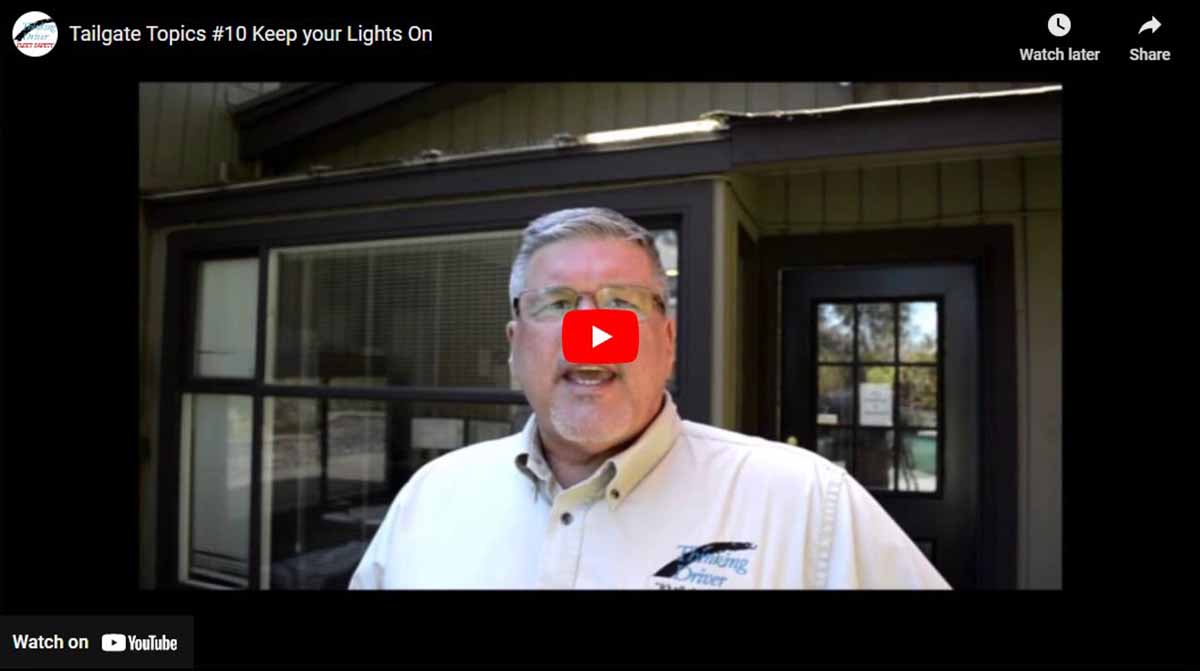Safety Meeting Planner & Agenda
Turn on Your Lights in Low Visibility!
Meeting Leader:
- Prepare in advance to make this meeting effective.
- Print and read over this entire agenda.
- Think about how you want to lead the meeting.
- Is there anything that is specific to your company or operation that you can include to personalize the information?
- Review the video for this session.
- Save the link to the video in your ‘Favourites’ folder on your browser for easy access.
- Open and then minimize the viewer just before the meeting to make the video introduction smooth.
Start Your Meeting!
Opening Statement:
Rear end collisions can cause severe vehicle damage and result in serious injuries.
Braking early to alert the driver behind is one way to reduce the chances of getting hit from behind but are there other strategies?
What else can you do to prevent another driver from running into you from behind? While you may not have any control over what the guy back there does, you do have some control over whether he sees you or not and if you fail to take the actions that you can to be visible, then you have failed to take every reasonable action to prevent the collision.
The Questions for this Meeting:
Q: What conditions could exist that could make it hard for the driver behind you to see you?
Answers:
- Fog
- Twilight
- Dusty conditions
- Snowy conditions
- Rain
- Essentially, any condition that impairs visibility.
Many drivers fail to adjust speed in adverse conditions and drive too fast causing them to ‘overdrive’ their headlights. In other words, they are going so fast that they can’t stop in the distance that they can see, so they are likely to hit a stopped or slow moving vehicle.
Q: What’s the best way to make your vehicle more visible from the rear in adverse conditions?
Answers:
TURN ON YOUR LIGHTS.
When others can see you, they are more likely to avoid conflicts. Using both headlights and taillights is your best strategy to ensure that other drivers have a good chance of seeing you.
Unfortunately, many of us don’t turn on our lights in low visibility because we either don’t think about this at all or we already have daytime running lights and think that this is sufficient to alert other drivers.
Daytime running lights have been required for vehicles in Canada since 1989 and they are common although not required in the US. The purpose is to enhance vehicle visibility – to make you more visible to other drivers.
This vehicle feature turns on the headlamps at a lower intensity as soon as the vehicle is started and put into gear, or the brake is released.
Daytime running lights don’t turn on the taillights though, so they don’t help with visibility from the rear.
Q: How many of you turn on the lights when visibility deteriorates to become more visible from the rear?
Answers:
For the ‘YES’ people: GREAT! Keep it up!
To the ‘NO’s’: Here is your challenge.
Practical Challenge:
The next time that you are driving in conditions that reduce visibility, turn on your lights and get the benefit of greater visibility from both front and rear and reduce your risk of getting rear ended!
Introduce the Video:
Spencer McDonald discusses the importance of turning on your vehicle lights when driving visibility deteriorates.









